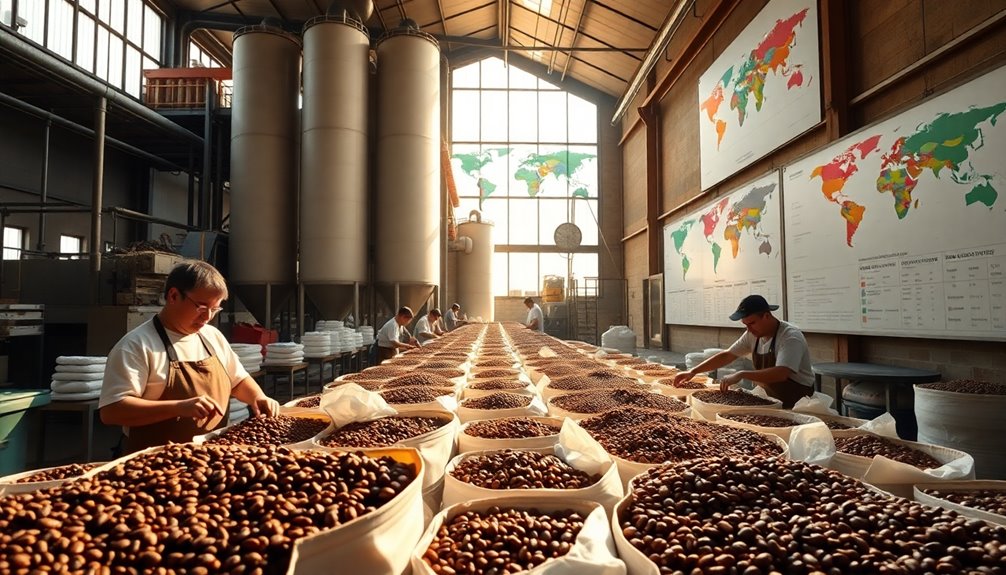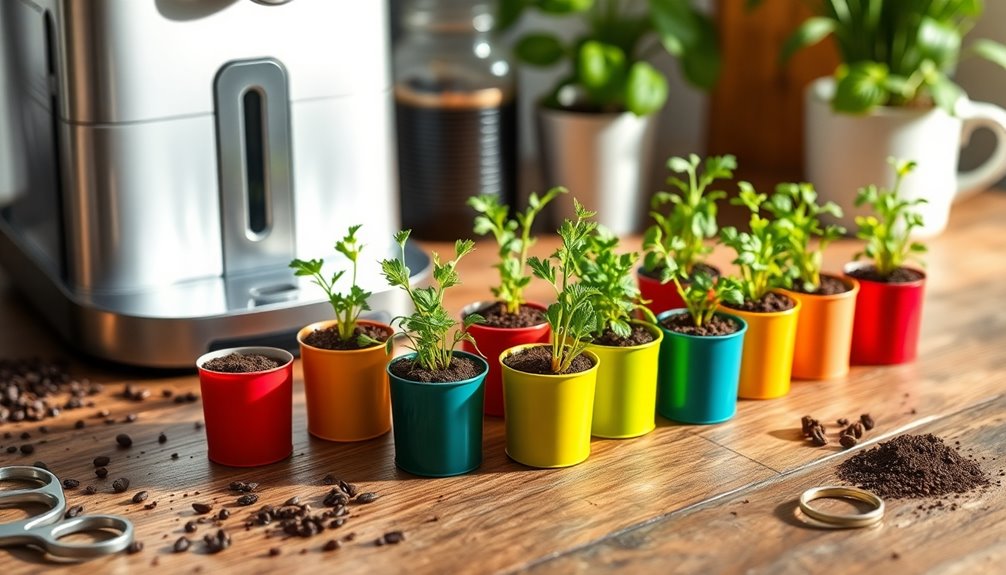AI in coffee sourcing offers great chances to improve transparency, efficiency, and sustainability. However, you need to be aware of risks like unfair trade practices, privacy concerns, and bias in decision-making. Larger producers might benefit more, risking inequality, while small farmers could be left behind. Ensuring ethical use means balancing innovation with fairness, privacy, and accountability. If you continue exploring, you’ll discover how to navigate these challenges responsibly and maximize AI’s positive impact.
Key Takeaways
- AI may prioritize cost savings over fairness, risking marginalization of small-scale farmers and reinforcing industry inequalities.
- Implementation of AI and robotics requires ethical oversight to ensure sustainable, fair sourcing practices.
- Data privacy concerns arise from collecting sensitive farm and farmer information, necessitating transparency and robust security.
- Lack of transparency in AI decision-making can obscure biases and hinder accountability in sourcing and pricing.
- Balancing AI-driven efficiency with ethical responsibilities is essential to promote fairness, trust, and sustainability in coffee supply chains.

As artificial intelligence becomes more integrated into coffee sourcing, it is essential to examine its ethical implications. One key area to consider is how AI impacts Fair Trade practices. Fair Trade aims to guarantee that coffee farmers receive fair compensation and work under ethical conditions. When AI algorithms are used to optimize supply chains, they can inadvertently prioritize cost reductions over fairness, potentially marginalizing small-scale farmers who lack access to advanced technology. If AI systems favor larger producers with better data infrastructure, it can undermine the very principles of Fair Trade, leading to a concentration of profits among big players and leaving small farmers vulnerable. To prevent this, you need to scrutinize AI decision-making processes, ensuring they promote equitable benefits and do not widen existing inequalities in the coffee industry. Additionally, the integration of robotics in supply chain logistics could further influence how efficiently and ethically coffee is sourced, requiring careful oversight. Data privacy also plays a key role in the ethical deployment of AI in coffee sourcing. As you collect and analyze vast amounts of data—from farm conditions to farmer identities—you must safeguard this information. Farmers and suppliers may be hesitant to share sensitive data if they fear misuse or breaches, which can hamper transparency and trust. Implementing strict data privacy measures isn’t just about compliance; it’s about respecting the rights of those involved. You should guarantee that data collection is transparent, consensual, and limited to what’s necessary for improving sourcing practices. Additionally, robust security protocols must be in place to prevent unauthorized access, as breaches could compromise individual privacy and damage relationships within the supply chain. Furthermore, you should consider how AI’s transparency and accountability are handled. If AI systems make decisions about sourcing or pricing, stakeholders need clarity on how those decisions are made. Without transparency, it’s difficult to detect biases or unfair practices, especially when algorithms are complex or proprietary. Maintaining accountability means regularly auditing AI systems and involving human oversight to catch errors or ethical lapses. Balancing innovation with responsibility is your challenge. While AI offers opportunities to improve efficiency, traceability, and sustainability in coffee sourcing, you must remain vigilant about its ethical pitfalls. Guaranteeing fair treatment of farmers, protecting data privacy, and promoting transparency aren’t just technical issues—they’re fundamental to building trust and integrity into the future of coffee sourcing. By prioritizing these ethical considerations, you can leverage AI’s benefits without compromising the core values that support a fair and sustainable coffee industry.
Frequently Asked Questions
How Does AI Impact Small-Scale Coffee Farmers’ Livelihoods?
AI can impact your livelihood by causing technological displacement, potentially reducing demand for manual labor. However, it also offers opportunities for farmer empowerment through access to better market data, weather forecasts, and sustainable practices. By adopting AI-driven tools, you can make more informed decisions, improve crop yields, and connect directly with buyers. Balancing these risks and opportunities helps you stay competitive and resilient in a changing coffee industry.
Can AI Algorithms Unintentionally Reinforce Coffee Supply Chain Inequalities?
Yes, AI algorithms can unintentionally reinforce coffee supply chain inequalities through algorithm bias and data privacy issues. When biases exist in training data, AI may favor large-scale producers over small farmers, exacerbating disparities. Additionally, if data privacy isn’t maintained, sensitive farmer information could be exploited, further disadvantaging smallholders. To avoid these risks, you should guarantee transparent data practices and regularly check for algorithm bias.
What Safeguards Ensure AI Transparency in Coffee Sourcing Decisions?
You can guarantee AI transparency in coffee sourcing by implementing safeguards like regular audits to detect algorithm bias and maintain data privacy. Clear documentation of how algorithms make decisions helps you understand their processes. Transparency standards, such as open algorithms or explainability tools, allow you to verify that sourcing choices are fair and ethical. These measures help build trust and reduce the risk of unintended biases influencing sourcing decisions.
How Is Consumer Data Protected in Ai-Driven Coffee Sourcing Systems?
Imagine a vault guarding your favorite coffee recipe—your data stays safe. In AI-driven coffee sourcing, your consumer data is protected through strict privacy measures and data anonymization, ensuring personal details stay hidden like a secret tucked away. These safeguards prevent privacy concerns from brewing into bigger issues, allowing you to enjoy ethically sourced coffee with peace of mind, knowing your information is shielded behind layers of secure encryption.
Are There Ethical Standards for AI Use Across International Coffee Markets?
Yes, there are ethical standards for AI use across international coffee markets. You should look for certifications like Fair Trade and Ethical Certification, which promote responsible sourcing and fair treatment of farmers. These standards guide companies to use AI ethically, ensuring transparency, fair wages, and sustainable practices. By adhering to them, you help support ethical sourcing and promote equity in the global coffee industry.
Conclusion
As you consider the role of AI in coffee sourcing, are you truly balancing innovation with integrity? While AI offers remarkable opportunities to improve transparency and fairness, it also presents risks like bias and exploitation. It’s up to you to guarantee that technology serves ethically, empowering farmers and protecting communities. Will you harness AI’s potential responsibly, or let ethical lapses undermine trust in your coffee supply chain? The choice is yours—what kind of future will you create?









